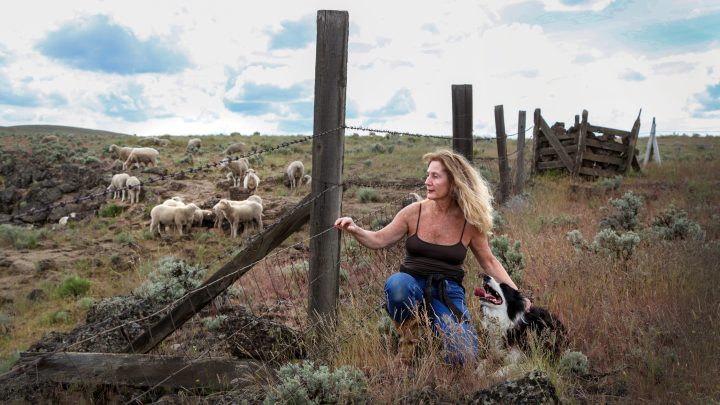
Ranchers, farmers look to ‘carbon farming’ as a way to diversify, and help the climate
Ranchers, farmers look to ‘carbon farming’ as a way to diversify, and help the climate

At the Imperial Stock Ranch in central Oregon, dozens of sheep were grazing on a recent fall day. Rancher Jeanne Carver watched a mama sheep scramble up a hill with two lambs.
“Look at that family goin’,” she said. “These families, they usually have twins.”
The sheep are helping the ranch take carbon dioxide out of the atmosphere and store it in the plants and soil, Carver said. Basically, by chomping on fields of grass.
“And then by their regrowth they’re stronger,” she said. “And we clean the CO2 out of the atmosphere at the same time.”
Carver manages the sheep on a planned grazing rotation. It moves them from pasture to pasture often enough to keep the grass growing and moving carbon dioxide from the air into the roots and soil.
Reducing the amount of carbon in the atmosphere is key to fighting climate change. Cutting emissions from fossil fuels is one way to do that, and another is by sequestering carbon — capturing and storing it in places that keep it out of the atmosphere.
Some of those places could be in the soil of farms and ranches. That’s why the Biden administration is spending billions of dollars to incentivize a practice known as carbon farming.
On Imperial Stock Ranch, keeping the sheep on a planned grazing rotation is just one piece of a broader carbon farming strategy.
Carver and her family have changed the kinds of plants they grow and now avoid tilling up the soil.
“Bare ground in general is not a good thing in terms of land health,” Carver said. “We want it to have plants, we want it to have diversity and we want it to have roots in the ground all the time.”
All of these changes help to put more carbon in the plants and in the ground, Carver said.
But she’s not asking anyone to take her word for it. The ranch hired a team of scientists to measure these changes with third party verification.
For Carver, it’s a survival strategy in a warming world.
“So the move toward climate impact measurement is huge,” she said. “And the reason I’m doing it is because I can see what’s coming.”
Soil samples across 32,000 acres show Imperial Stock Ranch stored more than a ton of carbon per acre last year.

That’s enough for Carver to make some extra money. She’s selling carbon offsets through a company called Agoro Carbon Alliance.
“They’re marketing as a sustainable wool,” said Jerry Stephens, a company sales manager. “There’s value in that. There’s value in organic, there’s value in sustainably raised or carbon friendly.”
The company has hundreds of contracts for carbon sequestration in agriculture.
Stephens said his sales pitch to farmers is less about fighting climate change and more about the healthier soil that comes with carbon farming.
“And as a result, companies that have emissions can pay you to store carbon for them,” he said.
But for polluters to pay for and claim carbon offsets, scientists say there needs to be a better way to measure exactly how much carbon dioxide is stored by these carbon farms and for how long.
“How do you prove that you’ve actually stored that carbon?” said Oregon State University soil scientist Markus Kleber.
Experts are still debating how to accurately measure carbon storage across a whole landscape over time, he said. It could take tons of measurements.
“It is not as easy as you hope it would be,” Kleber said. “It’s not like, ‘Oh yeah, we put the carbon underground.’”
So, putting carbon underground as a measurable climate solution that governments can count on to help save the planet? Kleber says we’re not there yet.
Still, he said, carbon farming is definitely worth a try.
On Imperial Stock Ranch, Carver is hoping one day she can sell both wool and carbon offsets to companies like Ralph Lauren. Who can then market carbon-neutral wool clothing.
“Why not buy those offsets from the farmers and ranchers who bring the fiber for your product?” Carver said. “This is the vision. This is the hope.”
It’s a vision she’s built with a network of ten ranches all measuring how much carbon they can store on more than two million acres across the West.
There’s a lot happening in the world. Through it all, Marketplace is here for you.
You rely on Marketplace to break down the world’s events and tell you how it affects you in a fact-based, approachable way. We rely on your financial support to keep making that possible.
Your donation today powers the independent journalism that you rely on. For just $5/month, you can help sustain Marketplace so we can keep reporting on the things that matter to you.

















